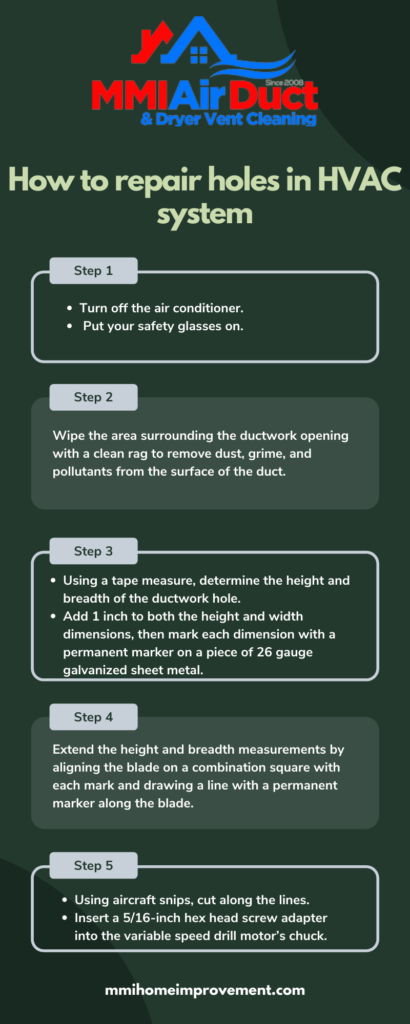To achieve peak performance, our heating and cooling system relies on your HVAC ductwork. On the other hand, Holes in your ducts can allow warm and cold air to escape, reducing the effectiveness of the entire system. That’s why you have to repair holes in HVAC ducts.
In addition to this, holes suck air pollutants into your home’s air, such as dust, mold spores, insulation fibers, and chemical odors, affecting your family’s indoor air quality. Therefore, Repairing duct damage is a simple undertaking that helps both your wallet and your health. You can also perform air duct dry fogging disinfection, GA. HVAC (heating, ventilation, and air conditioning) ducts are often built of lightweight sheet metal, whether solid or flexible. A hole in the ductwork will create leakage in the system and reduce the unit’s efficiency.
The greatest long-term fix for an HVAC sheet metal hole is to replace the whole length of the duct system. Sheet metal hole repair is not always possible at any given time. Wrapping a hole with duct tape is also ineffective since the adhesive on the tape may degrade and cause the duct tape to unravel nearly instantly. However, there is a form of wrap designed specifically for holes.
Tips For HVAC Holes:
1. Tape The Small Holes together
Firstly, wash the whole circle of your ducting with soapy water, rinse well, and let dry fully. Secondly, The duct opening can then be sealed using Underwriters Laboratory (UL) 181 foil-backed tape. Moreover, This tape is suitable for usage in high-temperature environments. Any tape that has not been authorized for use on ducting is a fire and smoke danger. Take a 6-inch piece of tape, place it slightly above one side of the opening, and wrap it around the duct. When you go back to your starting location, slightly overlap the tape and go around the duct again. Continue until the entire HVAC duct hole has been covered.
2. Repair The Larger Holes
Once you have cleaned the duct, measure the hole’s height and breadth, then add one inch to each. Mark these measurements with a marker on a strip of 26-gauge sheet metal and cut off the area with metal shears. Cover the HVAC duct hole with the sheet metal repair.
Use a power screwdriver to drive a #10 self-tapping sheet metal screw into each corner of the patch if you’re fixing a metal duct. Secure the patch to a fiberboard duct with a piece of foil tape on either side. Lastly and most importantly, apply a bead of silicone caulk around the patch’s borders to prevent air leakage.
How To Repair Holes In HVAC Ducts:
To optimize the efficiency of your HVAC ductwork, make sure the connections are tight and sealed with mastic or foil-backed tape, and that unconditioned ducts are insulated.
What You’ll Need
- Protective eyewear
- Sanitized rags
- A measuring tape
- A marker that is permanent
- Sheet metal with a gauge of 26
- Square combination
- Snippets of aviation
- Caulk made of silicone
- Knife for general use
- An eight-penny nail
- Caulk gun with drop-in capability
- Adapter for 5/16-inch hex head screws
- Self-tapping sheet metal screws
- Variable speed drill motor
- Tape made of metal foil
- Squeegee for plastic tape
- Duct couplings
Procedure:
Step 01:
Firstly, Turn off the air conditioner.
Step 02:
Secondly, Put your safety glasses on.
Step 03:
Thirdly, Wipe the area surrounding the ductwork opening with a clean rag to remove dust, grime, and pollutants from the surface of the duct.
Step 04:
Using a tape measure, determine the height and breadth of the ductwork hole.
Step 05:
After that, add 1 inch to both the height and width dimensions, then mark each dimension with a permanent marker on a piece of 26 gauge galvanized sheet metal.
Step 06:
Extend the height and breadth measurements by aligning the blade on a combination square with each mark and drawing a line with a permanent marker along the blade. Check that the two lines intersect.
Step 07:
Using aircraft snips, cut along the lines.
Step 08:
Insert a 5/16-inch hex head screw adapter into the variable speed drill motor’s chuck.
Step 09:
If you are placing the patch on metal ducting, place the cut piece of 26 ga sheet metal against the side of the ductwork and screw a #10 self-tapping sheet. Install a piece of metal foil tape on either side of the metal patch to adhere it to the ducting if you are placing it on fiberboard ductwork.

Use the below code to Embed this infographic
Step 10:
Continue to fasten the sheet metal patch to the ductwork by inserting #10 self-tapping sheet metal screws into each corner.
Step 11:
Most importantly, Open the end of a tube of silicone caulk by cutting the nozzle of the caulk tube at a 45-degree angle using a utility knife. The nozzle aperture should be 3/16-inch in diameter.
Step 12:
Insert an eight-penny nail into the nozzle of the silicone caulk tube until you feel it push through the membrane at the bottom of the nozzle.
Step 13:
Moving further, In a drop-in caulk gun, insert the opened tube of silicone caulk.
Step 14:
After that, To seal the metal patch to the ducting, apply a continuous bead of silicone caulk around the perimeter of the repair. Smooth the tape with a plastic squeegee to seal the metal patch if you put it on a fiberglass duct board.
Step 15:
Lastly, Turn on the HVAC unit when the silicone caulk has dried. If you put the patch on a fiberglass duct board, you may switch on the HVAC unit right away after smoothing the metal foil tape.
To transport air throughout your house, an HVAC system relies on the pressurization of the ductwork. Moreover, A hole in the ductwork prevents the HVAC system from pressurizing. Thus, reducing the HVAC system’s capacity to appropriately heat and cool your house. Repairing a ducting hole will boost the efficiency of your HVAC system, lowering your monthly energy expenditure.
However, The method you employ to repair the hole will be determined by the type of material used in your ductwork as well as the size of the hole you are mending. To avail professional services, you may also contact range hood installation, Smyrna.
Conclusion:
In conclusion, we can say that it is very crucial to repair holes in HVAC ducts. Firstly, it ensures the optimum working of the system. Secondly, it saves our energy bills. Moreover, insects cannot get into the ducts. Therefore, you should repair holes in HVAC ducts as soon as possible.
Must Read: How To Clean Air Ducts Yourself
